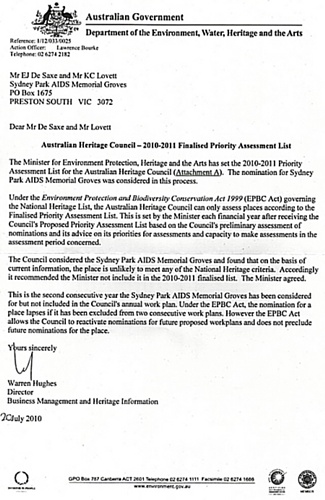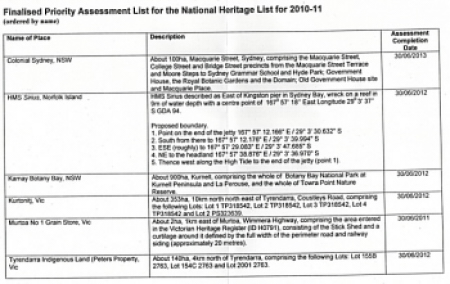


We received the following letter after waiting for two years to find out if our application to have SPAIDS listed on the National Heritage List had been successful. We were extremely disappointed at the outcome, and feel that the federal government has shown, once again, its contempt for anything relating to gay, lesbian, transgender and HIV/AIDS issues. Homophobia is once again very much to the foreground in this response where the AIDS Memorial Groves could well have been registered as a National AIDS Memorial. There is no other such permanent and easily accessible AIDS Memorial in Australia.
Sydney Park AIDS Memorial Groves is available to be used as an educational resource to teach about the nature of HIV and AIDS and also to be used for functions by AIDS-related organisations to remember and commemorate.



Enclosed is our submission to nominate the SPAIDS Memorial Groves in Sydney Park, St Peters/Alexandria, New South Wales, for inclusion in the National Heritage List (NHL).
Please note that we have attached a copy of the completed details required on the NHL Nomination Form to our Supporting Evidence documentation. We would also like you to note that telephone numbers and addresses as well as the names of some publications in supporting material may no longer be applicable.
We have attached to this letter a copy of the first page of information documenting the National AIDS Memorial Grove (NAMG) situated in Golden Gate Park, San Francisco, California, USA.
The Sydney Park AIDS Memorial Groves – SPAIDS – Project was inspired by this project in the USA.
We may be contacted by telephone, by email or by post as above.
E.J. De Saxe and K.C. Lovett.
Q1. What is the name of the place?
Sydney Park AIDS Memorial Groves – SPAIDS
Q2a. Where is the place? Address/location:
Within Sydney Park, St Peters/Alexandria, Sydney, New South Wales: South of Sydney Park Road which is the northern boundary, and East of Barwon Park Road, Southern end of King Street, Newtown and Erskineville, East of Princes Highway where King Street ends and Princes Highway begins. Campbell Road is the southern boundary and Euston Road is the eastern boundary.
Refer Q2c:1 – Google Map
Q2b. Boundary:
St Peters west of the ParkQ2c. Type of map you have supplied:
Google Map; Council Impression MapQ3a. Who owns it? Owner’s name (if more than one owner, attach a list):
Local Government – Sydney City Council, Town Hall, George Street, Sydney, NSW 2000 (Previously administered by South Sydney City Council before amalgamation with Sydney City Council)
Q3b. Is the owner (s) aware of the nomination?
YES (see letter from the Lord Mayor of Sydney, Clover Moore MP) Attachment Q3b.
Q4. Who has an interest in the place? This could include the property’s manager, local environment or historical groups, local council, indigenous people and developers or industry groups. Please provide names and contact details.
Sydney City Council – Clover Moore, Lord Mayor of Sydney, Sydney Town Hall 483 George Street Sydney NSW 2000;Q5. What is its significance? How would you tell people that this place has great importance to Australia? For example, why does this place, unlike other similar places, best highlight an outstanding aspect of Australia’s heritage?
Sydney Park AIDS Memorial Groves – SPAIDS - commemorate those who have died of HIV/AIDS. It is unique in that the Groves exist because they were planted by those in our communities who have been most affected by the epidemic – partners, family, friends, CSN carers, associates, government instrumentalities, the community at large.
7000 people have died of AIDS in Australia since the outbreak of the epidemic began in this country in 1983. Over 1200 of these people have been commemorated and listed, and those who were connected to them number in their thousands from around Australia. To these people the site has assumed the significance of a living memorial shrine in the form of a series of groves.
Furthermore, the policy of the Council has been to plant only Australian native species of trees (refer Q5-9) of the area in this park. Such a policy makes these Groves ideal as a national memorial as well as a suitable habitat for the return of the original birdlife to the area. Already many little grass birds, swamp and moorhens, magpies and black swans have begun to return (refer Q5-6,8).
There is no equivalent memorial in Australia, and Sydney City Council and South Sydney City Council, now amalgamated with Sydney City Council, ensured the permanence of the Groves by signage in the Park (refer Q5-1,2,3), and the building of a Reflection Area (refer Q5-4,5,6,7) looking out on the Groves.
Photos attached – labelled Q5: 1,2,3,4,5,6,7,8,9
Q6. Which criteria does it meet? Please try and identify each criterion from the list below which applies to the place and explain why it meets that criterion (attach evidence in relation to each criterion claimed to have been met).
The National Heritage criteria for a place are any or all of the following:
a. (tick) the place has outstanding heritage value to the nation because of the place’s importance in the course, or pattern, of Australia’s natural or cultural history
– see 6g attachments
b. not applicable
c. (tick) the place has outstanding heritage value to the nation because of the place’s potential to yield information that will contribute to an understanding of Australia’s natural or cultural history
– refer Q7a and Q8:1 attachments.
d. (tick) the place has outstanding heritage value to the nation because of the place’s importance in demonstrating the principal characteristics of:
l. a class of Australia’s natural or cultural places ore. (tick) the place has outstanding heritage value to the nation because of the place’s importance in exhibiting particular aesthetic characteristics valued by a community or cultural group
– refer Q5-6,8,9.
f. (tick) the place has outstanding heritage value to the nation because of the place’s importance in demonstrating a high degree of creative or technical achievement at a particular period
– refer Q5-5,7.
g. (tick) the place has outstanding heritage value to the nation because of the place’s strong or special association with a particular community group for social, cultural or spiritual reasons
– see attachment Q6g: 1,2
h. (tick) the place has outstanding heritage value to the nation because of the place’s special association with the life or works of a person, or group of persons, or importance in Australia’s natural or cultural history
– SPAIDS Reflection Area Dedication Address and Responding Address by then Mayor of South Sydney City Council John Fowler. Both dedication addresses meet all of the above criteria ticked. – see attachment: Q6h:1,2.
Q7a. How would you describe the place?
The Groves and Reflection Area combine aesthetic, spiritual and cultural associations in commemorating with permanence the devastation caused during the worst years of the AIDS epidemic in Australia from 1983 onwards. The place consists of a series of groves of Australian native trees and shrubs and bushes stretching from the western side of the Park and running south and east down towards the wetlands near the eastern boundary of the park. The Reflection Area is on a slope above the groves and looks out on them in all directions. A photo of the Reflection Area taken from the north looking south shows the Groves after 10 years of ongoing planting. (Attachment 7a)
Q7b. What condition is it in? Describe whether the place is intact or if there has been any damage or disturbance.
The site is maintained by Sydney City Council as it has a Plants and Trees Nursery next to the site of the Groves, and currently is in very good condition.Q8. What is its history? Summarise its origins and development. You may need to attach additional information.
Sydney Park was developed on the site of an old Brickworks and subsequent garbage dump. South Sydney City Council gained control of the Park around 1990 as a derelict dump, and set about transforming the area into an inner city park, similar to the city’s Centennial Park. After much of the pollution, some in the form of gases such as methane, had been eliminated, the Council set about laying out the Park and planting trees. Community groups were encouraged to plant Australian native species of trees, and SPAIDS was supported by Council in 1994 at its first planting on 15 May 1994.
Individuals who were carers of people with HIV/AIDS felt the need for a living memorial to those who had died from the disease, so Council was approached to set aside a section of this new park project for this purpose. Council agreed (refer Q6g:1). At the time the Council was organizing three (3) plantings a year in order to accelerate growth of trees.
SPAIDS persisted with Council and plantings, and now, with Sydney City Council in 2008, SPAIDS has had 33 plantings and planted over 8000 trees and commemorated over 1200 people – A LIVING MEMORIAL! Attachment 8: 1,2 and see also attachment for Q4.
Q9. What other places have similar characteristics? How do these places compare with the place you are nominating?
There are no other places in Australia with similar characteristics. SPAIDS is unique in Australia as a living AIDS Memorial. A recent and much smaller AIDS Memorial Tree Planting area is in Newcastle in Carrington, just over the bridge linking Carrington with Newcastle proper, inspired by SPAIDS, and a Memorial AIDS Garden in the grounds of Newcastle’s John Hunter Hospital.
Q10. What other information is available on the place? List any articles, books, reports or heritage studies that may provide evidence supporting your nomination. You may also have information from traditional Owners and Custodians, scientists or heritage specialists. If they have agreed to share their knowledge, please include their contact details.
Clover Moore, Lord Mayor of Sydney, has provided a letter of support for the Nomination and her letter is attached to the application form at Q3b. Sydney City Council is the Council responsible for the maintenance of the site.
Q11. Are there sensitive issues associated with the place? These may be issues that need to be kept out of the public eye such as matters relating to sacred or religious sites, or the location of rare fossils, plants or fragile places.
No. Nevertheless, a fossil of a large reptile-like creature, an amphibian, was discovered in the park around the turn of the 19th century. See South Sydney Council leaflet, attachment Q8:1
Q12. Do the values reflect a National Heritage Theme announced by the Minister?
Since the change of government on 24 November 2007 this information is not available at the moment.
* See attached Supporting Evidence for each checklist question.

GAY AND LESBIAN HOLOCAUST MEMORIAL - PART 3:


